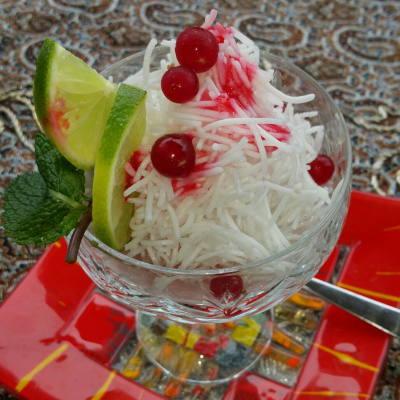What is Faloodeh (or Paloodeh)?
Faloodeh, is also known as Faluda and Paloodeh
Faloodeh (also spelled Paloodeh)--a Persian frozen dessert--is an ancient, much-beloved treat that originated in what is now the modern country of Iran. It’s completely unlike Western-style ice cream, though it does have some features in common with sorbet, and is made of such unusual ingredients as vermicelli rice noodles, rose water, lime juice, and cherry syrup--but it’s an incredible frozen dessert unlike anything else you’ll ever taste. Once you’ve tried faloodeh, you won’t want to go back to regular ice cream!
Legend has it that faloodeh was the first frozen dessert ever made--dating from around 400 BC--and that it was invented largely by accident, when flavoring syrups were spilled on snow, and people realized that they could be transformed into a delicious treat. Whatever the origin, Faloodeh is native to the city of Shiraz, and is often called Shirazi Faloodeh.
Faloodeh remains very popular in Iran to this day, served in coffee shops and ice cream parlors across the nation. It’s traditionally dyed with saffron, an exotic spice that imparts a subtle yellow color and almost undetectable floral flavor.
Faloodeh is often served alongside Persian-style dairy-based ice cream, which is similar to Western-style ice cream, but usually flavored with pistachios and honey. The combination of flavors and textures set this traditional Iranian dessert apart, and would be a big hit at a dinner party or a to finish off a romantic meal for two, especially in the heat of summer.
There’s very little more refreshing than this light, sweet dessert that dissolves on the tongue and isn’t quite like anything else in the world. It’s unusual texture, sweet flavor and cooling properties make it an instant favorite with nearly everyone who tries it.
Where to Get Faloodeh?
If you live Europe you can the brand "Bastani Tehran" at the Persian stores or order it at Persian Restaurants: Where to buy Bastani Tehran.
Outside of Iran, faloodeh can be difficult to come by. Some Middle Eastern grocers sell it packaged, and if you’re very lucky, you may live near an Iranian restaurant that serves it--many major cities have such restaurants, and it might just pay to make a quick search to see if there’s one local to you! If you have the opportunity to try it this way, you should take it.
If you can’t find it in at your local Middle Eastern grocer and you have no luck finding a local Iranian restaurant, you can make your own at home--with the shortcut of buying your vermicelli instead of making it, it’s a quick and simple process that gives truly impressive results. Anyone you serve it to will think you’ve gone to hours of effort; only you need to know the truth!
Quick and Simple Faloodeh Recipe
For this recipe, the only equipment you’ll need is a few ice cube trays, a medium saucepan, a mixing bowl, and a blender. You’ll also need some serving dishes--traditionally, faloodeh is served in a glass, but there’s nothing wrong with serving it in a bowl.
The ingredients, for the most part, should be easy to come by. Rice vermicelli should be in the international food aisle of your local supermarket, as will the sour cherry syrup--though this may require a trip to your Middle Eastern grocer, depending on where you live--rosewater should be available in the baking section, and lime juice should be with sauces.
This recipe replaces expensive saffron with yellow food dye, but if you’d like to make a more authentic dish, there’s no reason you can’t use saffron. Simply soak a few saffron threads in a teaspoon of water until the water turns yellow--ideally overnight--and add it in place of the dye, removing the saffron threads beforehand.
The active time for this recipe is about 10-15 minutes, with around 2 hours of freezing time on top of that, so it’s best to start your preparations before you start dinner, if you mean to serve it as a dessert.
Faloodeh will keep indefinitely in the freezer, but is best enjoyed within a few days, since the texture will change over time and the noodles may become fused together by ice buildup after a while. It’s so quick and simple that you could make a new batch every day if you wanted, so don’t worry too much about the keeping time!
Ingredients
- 50g rice vermicelli, cooked, chilled
- 150g caster sugar
- 500ml water
- 60ml lime juice
- 2 tbsp rose water
- 80ml sour cherry syrup
- 1-2 drops yellow food dye (optional)
- 50g pistachios, crushed, to serve
- Pistachio and honey ice cream, to serve
Method
- Cook rice vermicelli according to packet directions. Usually, this will involve soaking the noodles in boiling water for around five minutes. Once the noodles are cooked, drain them and place them in the refrigerator to chill them while you perform the next steps.
- Combine caster sugar and water in a medium saucepan over a low heat, stirring until sugar is fully dissolved. Allow to cool for about five minutes, then add lime juice, optional food dye, and rose water.
- Pour sugar and water mixture into ice cube trays and place in freezer. Allow to chill until frozen, at least 1.5 hours.
- Crush ice cubes in a blender until finely crushed, but do not allow them to melt.
- Combine crushed ice with vermicelli and return to the freezer for about fifteen minutes, or until noodles have gone white and are frozen.
- Break up as required and divide between serving glasses. Pour cherry syrup over immediately before serving. Top with crushed pistachios.
- Optionally, add a scoop of pistachio and honey ice cream (or plain vanilla if you can’t get the pistachio flavor) to the bottom of the glass before serving--this will keep the Faloodeh frozen for longer, and add an extra level of decadence to the whole dessert.
Optional garnishes could also include lime wedges, fresh or preserved cherries, fresh mint sprigs or pomegranate seeds, all of which are traditional.
If desired, the food dye color could be varied to produce different results--little girls would likely be thrilled with this iced confection in pink or purple, for example.
As a variation, orange blossom water can be substituted for rose water. In this case, exchange the lime juice for the same amount of lemon juice, to enhance the subtle citrus flavors.
Of course the Faloodeh of Bastani Tehran is amazing and worth the try. Try it!
Don’t forget to read this article: How to make Persian Ice cream (bastani) at home?

